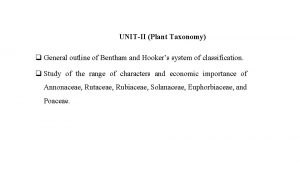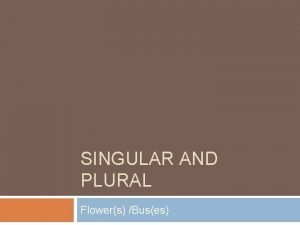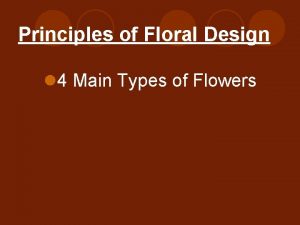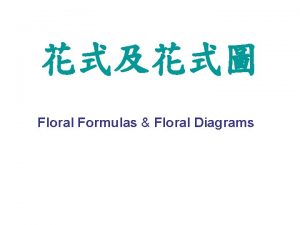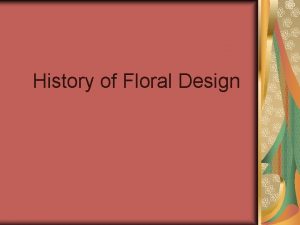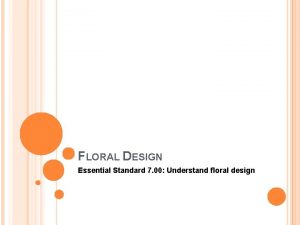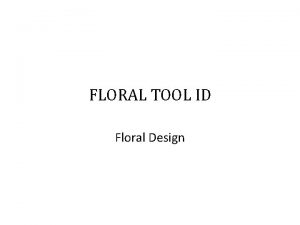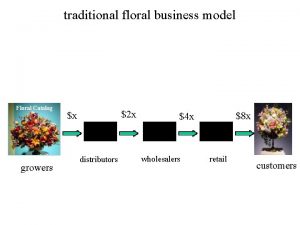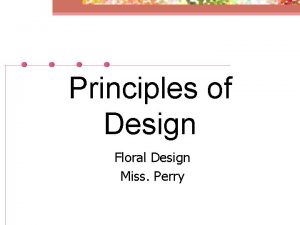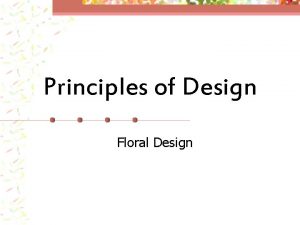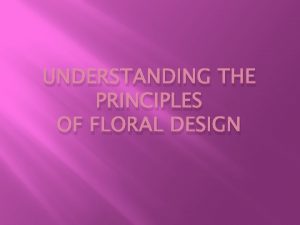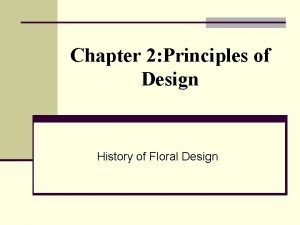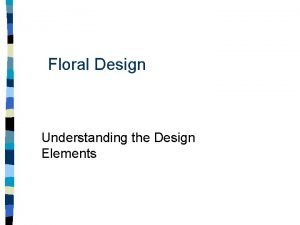Principles of Design Floral Design The Principles of






















- Slides: 22

Principles of Design Floral Design

The Principles of Design are… • • Focal Point Proportion Scale Balance Rhythm Harmony Unity

Focal Point • The center of interest in a design • Draws the most attention and directs the viewer’s eye to a specific location within a design. • Located slightly above the rim of the container and extends slightly out in front of the container to give depth.

Where is the Focal Point?

Proportion • Concerns the relationship between the flowers, foliage, and container. • To attain proper proportion: – Smallest flowers should be positioned at the top and edges of the design and as you work towards the focal point gradually increase the flower size. – Plant material should be 1 ½ to 2 times the size of the container

Proportion • Do these arrangements achieve proper proportion?

Scale • The relationship between the completed arrangement and its location or surroundings. • Arrangement should “fit in” where it is placed. • Example: A small arrangement on a large table shows improper scale.

In Scale or Out of Scale?

Balance • Provides an arrangement with the impression of being stable and selfsupporting. • Gives “visual weight” to the arrangement and makes it more pleasing to the eye. • Can have symmetrical balance or asymmetrical balance

Symmetrical Balance • Formally balanced • Same on each side, appears to be an imaginary vertical line running through the center of the arrangement. • Passive and restful tone

Asymmetrical Balance • Informal and more natural design. • The two sides are completely different, but, visual weight appears equal and balanced.

Overall Balance • Top to Bottom – The bulk of the weight should on the lower half of the arrangement near the rim of the container to achieve proper balance.

• Front to Back – Smooth and gradual flow from the top flower to the bottom outermost flowers. – Tip the top rear flower slightly backward to produce depth and visual balance (flowers toward the top should not lean over the flowers positioned below).

Rhythm • The apparent flow of lines, textures, and colors that express a feeling of motion rather than confusion. • Rhythm provides a sense of beauty. • Can be achieved through repetition, radiation, and transition.

Achieving Rhythm through Repetition • Accomplished by repeating one or more of the design elements such as color, line, pattern, shape, space, or texture. • Repetition allows the eye to move smoothly from one area to another so the viewer can “see” the entire design.


Achieving Rhythm through Radiation • Placing flowers with their stems originating from the focal point so the flowers appear to radiate from the center of the design.

Achieving Rhythm through Radiation • Creates emphasis at the center of interest and provides visual movement throughout the arrangement. • Gives strong sense of unity and grace to arrangement.

Achieving Rhythm through Transition • Creates a sense of motion within the design that leads the eye to the center of interest. • Produced by repeating similar shapes in a systematic size progression or spacing identical shapes in a systematic space gradiation to achieve transition.


Harmony • For harmony to be achieved, all the parts of the design must be blended in a pleasing relationship. • The flower shapes, colors, textures, and sizes should “fit together” to express a central theme or idea.

Unity • Achieved when all parts of the design combine w/o noticeable separation. • The arrangement should be a complete unit, not just a group of flowers thrown together.
 Floral pricing worksheet answer key
Floral pricing worksheet answer key Annona squamosa floral formula
Annona squamosa floral formula What is plural form of bus
What is plural form of bus Radial balance in floral design
Radial balance in floral design Tension in floral design
Tension in floral design Hình ảnh bộ gõ cơ thể búng tay
Hình ảnh bộ gõ cơ thể búng tay Lp html
Lp html Bổ thể
Bổ thể Tỉ lệ cơ thể trẻ em
Tỉ lệ cơ thể trẻ em Voi kéo gỗ như thế nào
Voi kéo gỗ như thế nào Tư thế worms-breton
Tư thế worms-breton Bài hát chúa yêu trần thế alleluia
Bài hát chúa yêu trần thế alleluia Các môn thể thao bắt đầu bằng tiếng bóng
Các môn thể thao bắt đầu bằng tiếng bóng Thế nào là hệ số cao nhất
Thế nào là hệ số cao nhất Các châu lục và đại dương trên thế giới
Các châu lục và đại dương trên thế giới Cong thức tính động năng
Cong thức tính động năng Trời xanh đây là của chúng ta thể thơ
Trời xanh đây là của chúng ta thể thơ Mật thư anh em như thể tay chân
Mật thư anh em như thể tay chân 101012 bằng
101012 bằng độ dài liên kết
độ dài liên kết Các châu lục và đại dương trên thế giới
Các châu lục và đại dương trên thế giới Thể thơ truyền thống
Thể thơ truyền thống Quá trình desamine hóa có thể tạo ra
Quá trình desamine hóa có thể tạo ra

